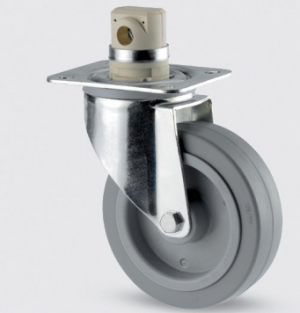
It’s always recommended to consult an expert that may save some time and make you aware of unknown circumstances in your particular situation. A perfect solution is based on a case-by-case study and often requires custom work. This article focuses on selection criteria on mobile solutions for material handling equipment.
Load rating
The equipment or device is rated at 2,400 lbs and thus many people think 600 lbs per caster is sufficient. A caster should always travel firmly on the floor. Casters often lose contact briefly with the floor on uneven surfaces, rolling over thresholds, tracks or potholes. Suddenly they are overloaded when only three of the four casters touch the ground and the three casters have to bear the whole load. This must be taken into consideration when calculating the load capacity. The following formula provides the necessary safety reserves:
> Tare-weight of the device + load divided by 3 = min. dynamic load capacity / caster
Pushing or pulling?
Preferably the application should be designed to be pushed and not only pulled, to reduce the possibility of injuries to a minimum. Pulling is only possible with either arm stretched out at the back, which may result in being “run-over” by the equipment. At times the equipment being pulled can be very heavy or taller than the person pulling the cart, which in turn can impede the line of sight for the person pulling the equipment.
Push and pull forces
The most important factor besides the load rating is ease of movement or maneuverability. An easy to move equipment is a piece of equipment that will be used and moved often, with little effort and therefore a lot faster. It all adds up to the point that reduces downtime and increases output. The initial starting force is always the greatest to overcome. The rolling resistance is significantly lower and should not be considered as a determining factor for choosing the right wheel type. The following points determine push and pull forces.

Polyurethane (flat & convex); great compromise between push and pull forces and ground pressure with medium shore hardness around A92 is in most cases your best choice.
Polyamides give you the lowest push and pull forces due to hard tread material and shore hardness of D75. Ground pressure is very high and only recommended with extra heavy loads where a low overall height is required. Check your flooring before choosing PA material because high and concentrated ground pressure may leave wheel ruts and may damage expensive flooring. Keep in mind that once the equipment is rolling it may be difficult to stop safely.
Rubber is probably the most well known tread material. It’s a noise-free movement and has the highest push and pull forces and the lowest ground pressure with shore hardness around A67. The load capacity of rubber is usually lower than of any other material. It is great for transporting sensitive equipment, as it provides a cushioned ride.
Also consider possible resistance against oils, chemicals and metal debris depends on the wheel and time of exposure.
Swivel resistance
Swivel resistance depends not only on wheel type and offset, but also on the bearing type. A precision ball bearing in the swivel head gives minimum resistance and is possible up to a certain load capacity. For extra heavy loads a dual-way ball race may be required.
Wheel bearing
Besides the tread, wheel diameter and swivel bearing, the wheel bearings determine how smooth a caster will travel and thus the quality of the caster.
Roller bearings: Besides the friction and deep groove ball bearings; this robust type of a shock-resistant bearing is mainly used for transport equipment casters. Roller bearings are characterized by their low installation height; relatively low rolling resistance and high load capacity among other things. The travelling speed of wheels with roller bearings should not exceed 4 km/h.
Precision ball bearings: The various designs of single row radial precision ball bearings to DIN are the highest quality type bearings. Wheels with these bearings have extremely low roll resistance for maximum load capacity.
Plain bearings: The simplest forms of wheel bearings are the plain or friction bearings. They are shock-resistant, and depending on the material properties corrosion proof. Plain bearings should be used for wheels on equipment, which is moved with a low velocity over short distances.
Make sure your supplier provides you with maintenance free bearings for optimal performance and minimum maintenance cost and downtime.
Offset
The larger the offset the lower the swivel resistance; a large offset increases the swivel radius and may cause interference with other components or may stick out too far and possibly hurt workers or cause injuries.
Single or twin wheel
In cases where a low overall height is required in combination with a high load capacity a twin wheel will be the best choice. The main advantage is to reduce the swivel resistance. A single wheel stays in place and the caster swivels around it; it causes high friction and therefore a greater resistance. Using a twin wheel, the wheels are turning in opposite direction, while the caster swivels around, which reduces ground friction to a minimum and gives greater performance.
Wheel diameter
The most significant impact on resistance is the wheel diameter. For loads greater than 2,000 lbs, we highly recommend using a 6″ wheel or larger wheel diameter to maneuver the equipment safely. The general rule applies to most situations: “The higher the load, the bigger the wheel diameter should be.”
What’s right for you?
We recommend talking to an expert and performing a test at your site with different caster and wheel types. Please consider this information as a guideline and advice for your next project. It will give you peace of mind that your organization did the best it could to prevent accidents and provide the best possible mobile solution. Help increase awareness throughout your organization, your suppliers and your customers.